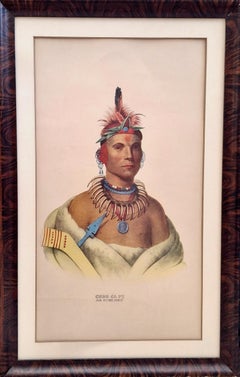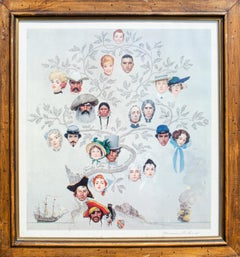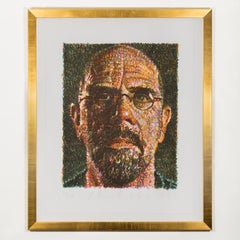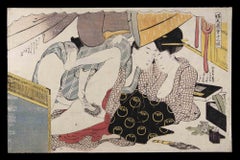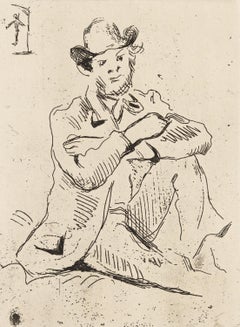Men Portrait Prints
to
765
1,238
499
471
258
161
Overall Width
to
Overall Height
to
875
467
150
144
55
49
47
42
37
23
16
7
4
1
111
56
36
25
19
149
686
1,304
500
22
62
89
59
61
75
158
215
135
83
117
2,039
484
99
6,545
3,598
3,111
2,640
1,909
1,543
1,231
1,155
930
788
751
444
392
386
251
211
197
195
179
168
1,034
683
438
201
137
332
1,244
1,240
891
Art Subject: Men
“Chono Ca Pe, An Ottoe Chief”
Located in San Francisco, CA
Chono Ca Pe, is the remarkably handsome man looking back at us across some 200 years, expressing a certain wariness of the white man painting him. Also known as Big Kansas, the sitte...
Category
Mid-19th Century Realist Portrait Prints
Materials
Lithograph, Paper
Norman Rockwell "Family Tree" Lithograph
Located in New York, NY
Norman Rockwell (American, 1894-1978)
Family Tree
Original painting produced 1959, this print published 1959 in Japan by The Curtis Publishing Company
Lithograph
Sight: 19 1/4 x 13 3...
Category
1920s American Modern Figurative Prints
Materials
Lithograph
Rare (Historic) Atlantic House, Provincetown - Entre Nous - Chains -offset print
Located in New York, NY
Robert Mapplethorpe
Rare (Historic) Atlantic House, Provincetown - Entre Nous - Chains poster, 1991
Offset lithograph poster
17 × 11 inches
Unframed, unsigned and unnumbered
Accompan...
Category
1990s Pop Art Figurative Prints
Materials
Lithograph, Offset
Self-Portrait
By Chuck Close
Located in Toronto, Ontario
Chuck Close (1940-2021) was known for both his meticulous attention to detail and his innovative approach to the genre of portraiture.
Having pioneered the Photorealism movement in ...
Category
Early 2000s Contemporary Portrait Prints
Materials
Lithograph, Screen
Shunga - Woodcut by Katsukawa Schuncho - Mid-18th Century
Located in Roma, IT
Shunga is an original modern artwork realized by Katsukawa Schuncho (1726 – 1793) in the half of the 18th Century.
Erotic scene from the series "Koshuko zue juni ko".
A courtesan with a customer under a kimono stand...
Category
Mid-18th Century Modern Portrait Prints
Materials
Paper, Woodcut
Portrait des Malers Armand Guillaumine mit dem hängenden Mann
By Paul Cézanne
Located in Wien, 9
Paul Cézanne (1839–1906) was born in Aix-en-Provence and initially studied law, as per his father's wishes. However, he soon turned to art, taking evening drawing classes at the Écol...
Category
Late 19th Century Modern Portrait Prints
Materials
Etching
Chittee-Yoholo, Seminole Chief: Original Hand-colored McKenney & Hall Lithograph
Located in Alamo, CA
This is an original 19th century hand colored McKenney and Hall engraving of a Native American entitled "Chittee-Yoholo, A Seminole Chief, No. 76", published by Rice, Rutter & Co. in 1865.
This original McKenney and Hall engraving is presented in a cream colored mat, suitable for framing, with a protective clear sleeve. The mat measures 13.88" x 11.75" and the sheet measures 10.63" x 7.38. The print is in excellent condition.
Col. Thomas J. McKenney was Superintendant of The Bureau of Indian Affairs from 1816 until 1830. He was one of a very few government officials to defend American Indian interests and attempt to preserve their culture. He travelled to Indian lands meeting the Native American leaders. He brought with him an accomplished artist, James Otto Lewis, who sketched those willing to participate. A large number of the most influential Indian chiefs and warriors were later invited to come to Washington in 1821 to meet President Monroe. McKenney commissioned the prominent portrait painter Charles Bird King...
Category
Mid-19th Century Naturalistic Portrait Prints
Materials
Engraving
Origiinal France du Pacifique, New Caledonia vintage French travel poster
Located in Spokane, WA
Original "France du Pacifique, Nouvelle-Calédonie" vintage poster by Cras Monique (c. 1960s). L'île de Lumière (The Island of Light). Archival linen-backed in very good condition (see images), ready to frame. Printer: Sicard – Paris. The poster combines Art Deco and modernist influences, highlighting a romanticized view of travel and exotic destinations.
Embodies the spirit and traditions of New Caledonia. He is shown in bold, stylized colors typical of mid-century travel art. The man’s skin is a rich, warm brown, and his dark, curly hair is topped with a simple headband or traditional accessory that hints at local customs. His clothing is minimal, reflecting both the tropical climate and authentic ceremonial attire—perhaps a patterned sash or wrap around his waist.
He lifts a large conch shell to his lips, caught in the act of blowing into it. The shell itself is an impressive, natural object, likely a Triton’s trumpet...
Category
1950s Art Deco Portrait Prints
Materials
Offset
St. George — African American artist
By John Tarrell Scott
Located in Myrtle Beach, SC
John Tarrell Scott, 'St. George', woodcut, edition 20, 1992. Signed, dated, titled, and numbered '18/20' in pencil. A fine, black impression, on off-white, laid Japan paper, with ful...
Category
1990s Contemporary Portrait Prints
Materials
Woodcut
Francesco Clemente, Geography, North
Located in New York, NY
NORTH
Year: 1992
Medium: 2-color, soft ground etching
Paper Size: 28 x 25 inches (71 x 64 cm)
Plate Size: 19 x 18 inches (48 x 46 cm)
Edition: 60
Price: $6,000
Suite of four also a...
Category
1990s Contemporary Figurative Prints
Materials
Etching
Prince William
Located in New York, NY
This bold color lithograph is signed, dated and numbered in pencil by Peyton, from an edition of 350. Published by the Public Art Fund, New York.
Category
Early 2000s Contemporary Figurative Prints
Materials
Color, Lithograph
Lt General Higginson, Vanity Fair military caricature portrait, 1884
Located in Melbourne, Victoria
'A Good Soldier'
Chromolithograph. 1884.
Vanity Fair portrait of Lt.General George Wentworth Alexander Higginson. He joined the Grenadier Guards at 19 and fought in the Crimean W...
Category
Late 19th Century Victorian Figurative Prints
Materials
Lithograph
Original "BEWARE Spreading Vital Informaton .. SILENCE" vintage WWII poster
Located in Spokane, WA
Original "Beware Spreading Vital Information Will Undermine Our War Effort. Do your Part In Silence" vintage World War 2 poster.
Ori...
Category
1940s American Impressionist Portrait Prints
Materials
Lithograph
$600 Sale Price
20% Off
PEPPER JELLY LADY Hand Signed Lithograph, Black Woman, Rooster, Family Memories
Located in Union City, NJ
PEPPER JELLY LADY is a hand drawn, limited edition lithograph by one of the most important American artists of the 20th century, Romare Bearden. PEPPER JELLY LADY was printed using t...
Category
1980s Contemporary Portrait Prints
Materials
Lithograph
Matisse Reflexion Vintage Modern Mid Century
Located in Brooklyn, NY
This artwork by Henri Matisse is a lithograph page from the book Cinquante Dessins, published by Les Soins de L'Artiste in 1920.
First Edition. The portfolio was edited and printed...
Category
1920s Modern Portrait Prints
Materials
Lithograph
$900 Sale Price
40% Off
Leonard Braund, Empire Cricketeer, English cricket portrait lithograph, 1905
Located in Melbourne, Victoria
Leonard Braund was a bowler for Somerset and England.
Tayler was an English artist who was a member of the Royal Academy of Painters. He was a cricketer himself, and in 1905 he made...
Category
Early 20th Century Victorian Portrait Prints
Materials
Lithograph
Lionel Charles Palairet, Vanity Fair cricket portrait chromolithograph, 1903
Located in Melbourne, Victoria
'Repton, Oxford & Somerset'
Vanity Fair portrait of Lionel Charles Hamilton Palairet (1870-1933) who was an English amateur cricketer who played for Somerset and Oxford University....
Category
Early 20th Century Victorian Portrait Prints
Materials
Lithograph
'The Lord Mayor' (Sir Joseph Dimsdale), Vanity Fair caricature portrait, 1902
Located in Melbourne, Victoria
'The Lord Mayor'
Chromolithograph. 1902.
Vanity Fair portrait of Sir Joseph Cockfield Dimsdale (1849-1912), Lord Mayor of London 1901-1902.
With original descriptive text.
395mm...
Category
Early 20th Century Victorian Figurative Prints
Materials
Lithograph
The Wrath of Elihu: 'I Am Young, And Ye Are Very Old, Wherefore I Was Afraid.'
Located in Storrs, CT
The Wrath of Elihu. 'I Am Young, And Ye Are Very Old, Wherefore I Was Afraid'. 1823-25. Engraving. .Binyon catalog 117 state ii, Bindman catalog 632. Image 7 7/8 x 5 15/16; plate 8 ...
Category
Early 19th Century Romantic Figurative Prints
Materials
Engraving
Original 'The U. S. Marines Want You' vintage military recruiting poster
Located in Spokane, WA
Original vintage poster: The U.S. Marines Want You. This military vintage poster is archival linen-backed and in fine condition, ready to frame. There is no date, artist, or printer'...
Category
1910s American Realist Portrait Prints
Materials
Lithograph
Dame mit Reiher (Woman with a Tuft of Heron Feathers) /// German Expressionism
By Otto Dix
Located in Saint Augustine, FL
Artist: Otto Dix (German, 1891-1969)
Title: "Dame mit Reiher (Woman with a Tuft of Heron Feathers)"
Portfolio: Die Schaffenden, Vol. 5, No. 1
*Signed and dated by Dix in pencil lower right
Year: 1923
Medium: Original Lithograph on light cream smooth wove paper
Limited edition: approx. 120
Printer: likely the artist Dix himself, Düsseldorf, Germany
Publisher: Euphorion Verlag, Berlin, Germany
Reference: "Otto Dix: Das Graphische Werk" - Karsch No. 62/II c, pages 84, 147
Framing: Recently beautifully framed in a modern gold moulding with 100% cotton rag matting and Museum Glass
Framed size: 26" x 21.82"
Sheet size: 16.25" x 12.25"
Condition: In excellent condition
Rare
Notes:
Provenance: private collection - Robert Kuennen, Oberlin, OH. Euphorion Verlag chop mark/blind stamp lower right. "Dix Fraukopf" (Dix Woman Head) pencil inscribed lower center.
"The brim of her hat loops to make a shadow, the better to show her gaunt profile. Strands of hair writhe against her cheek and complement a fur stole on her shoulder. In 1923 Otto Dix went to Düsseldorf to learn new printing skills, including lithography which would show his drawing skills to better effect. He made a series of character studies, including this affecting portrayal of a pale woman reduced almost to a shadow of herself. Eyes closed to the exquisite world represented by those materials set out by the artist, she seems scarcely aware." - Sotheby's, London, UK
Biography:
Otto Dix (born December 2, 1891, Untermhaus, Thuringia, Germany—died...
Category
1920s Expressionist Portrait Prints
Materials
Lithograph
Le Retour de Paris /The Niece presented to her Relatives by Her French Governess
Located in Middletown, NY
London: Thomas McLean, 1835.
Etching with hand coloring in watercolor on cream wove paper, 4 3/4 x 6 1/2 inches (120 x 165 mm), full margins. Printed by Thomas McLean. Light, small c...
Category
Early 19th Century Victorian Figurative Prints
Materials
Etching, Watercolor
19th Century Japanese Woodblock - Restraint
Located in Corsham, GB
A dynamic Japanese woodblock depicting a woman captured with her hands behind her back. Signed and inscribed with characters. Presented in a contemporary black frame. On paper.
Category
19th Century Portrait Prints
Materials
Woodcut
$302 Sale Price
20% Off
GEECH Signed Lithograph, Man Working, Lowcountry SC, Gullah Geechee Culture
Located in Union City, NJ
GEECH is a hand drawn, limited edition lithograph(not a digital print or photo reproduction) by JONATHAN GREEN printed using hand lithography techniques...
Category
Early 2000s Contemporary Portrait Prints
Materials
Lithograph
$3,840 Sale Price
20% Off
Original Visitate l'Exposizione Coloniale Parigi vintage travel poster
Located in Spokane, WA
Original travel poster: Visitate l'Esposizione Coloniale A smiling dusky maiden who looks just like Josephine Baker, pushes aside a blue curtain to reveal the splendors of her nat...
Category
1930s Art Deco Portrait Prints
Materials
Lithograph
Camille Portrait
Located in Brooklyn, NY
This lithograph, titled Portrait of Camille, is a significant work by the French Fauvist artist Georges Rouault. Executed with precision by lithographer Daniel Jacomet, this print is...
Category
Late 20th Century Modern Portrait Prints
Materials
Lithograph
$320 Sale Price
20% Off
Slawn "Superman" Fine Art Print Contemporary Street, 2025
Located in Draper, UT
Materials:
Presented on acid-free, archival cotton PhotoRag Giclee paper from Hahnemuhle
Size
11 × 14 in 27.9 × 35.6 cm
Rarity
Medium:
Fine Art Print
Condition:
Print is in pristi...
Category
2010s Street Art Portrait Prints
Materials
Screen
Charles John Darling, lawyer, Vanity Fair caricature portrait, 1897
Located in Melbourne, Victoria
'Little Darling'
Chromolithograph. 1897.
Vanity Fair musician portrait of Charles John Darling (1849-1936), lawyer, politician and High Court judge.
395mm by 265mm (sheet)
Category
Late 19th Century Victorian Figurative Prints
Materials
Lithograph
Oval Head of a Woman with Piercing Eyes (Plate XXI), from Carmen
Located in Washington, DC
Artist: Pablo Picasso
Title: Oval Head of a Woman with Piercing Eyes (Plate XXI)
Portfolio: Carmen
Medium: Etching on Montval wove paper
Year: 1949
Edition: 289
Frame Size: 21" x 18"...
Category
1940s Cubist Portrait Prints
Materials
Etching
Original "Beat Back the Hun with Liberty Bonds" vintage World War One poster
Located in Spokane, WA
Original Beat Back the Hun with Liberty Bonds vintage military poster.. Artist F. Strothmann. Original World War 1 antique vintage poster; archival linen backed and ready to fram...
Category
1910s American Impressionist Portrait Prints
Materials
Lithograph
Mr Brainwash - Love Catcher (Blue), Street Art
By Mr Brainwash
Located in London, GB
Mr. Brainwash
Love Catcher - Blue, 2023
Screenprint on Archival paper
22 × 22 in 55.9 × 55.9 cm
Frame included
Edition 30 of 75
Mr. Brainwash, the pseudonym of Thierry Guetta, is a...
Category
2010s Street Art Figurative Prints
Materials
Screen
VOTE BIDEN, signed Lt Ed screenprint based upon Warhol's portrait of McGovern
Located in New York, NY
Dread Scott
VOTE BIDEN, 2020
Screenprint on wove paper
Signed, dated and numbered 24/100 in graphite pencil on the back
26 × 26 inches
Unframed
The screenprint, which references And...
Category
2010s Contemporary Portrait Prints
Materials
Screen
Original Ingen Rast, Ingen Ro No Rest No Peace Hobbs in a Hurry Silent movie
Located in Spokane, WA
Original Ingen Rast, Ingen Ro, a Swedish vintage silent movie poster from 1920. Translated, it means No Rest, No Peace. However, the American titl...
Category
1920s Art Deco Figurative Prints
Materials
Lithograph
Apache Chief Geronimo
Located in Aventura, FL
Enamel screen print on Somerset paper. Hand signed, dated and numbered on front by Russell Young. Image size 19.5 x 16 inches. Sheet size 27 x 22 inches. Edition of 27/30.
Art...
Category
2010s Contemporary Portrait Prints
Materials
Enamel
$1,837 Sale Price
25% Off
"1993 in Review" Broadway, Movies, Dance, Film, Opera, Nureyev, Bette Middler
Located in New York, NY
"1993 in Review" Broadway, Movies, Dance, Film, Opera, Nureyev, Bette Middler
Al Hirschfeld (1903-2003)
"1993 in Review"
Lithograph on heavy paper
Sight: 22 x 16 inches
Signed lower...
Category
1990s Performance Figurative Prints
Materials
Paper, Etching, Lithograph
Prometheus, by William Wolff
Located in Palm Springs, CA
Wolff’s woodcut of the mythological figure of Prometheus is carved and printed in only two strong colors—black and a fiery red-orange—yet the impact is monumental. The central figure...
Category
1990s Contemporary Portrait Prints
Materials
Woodcut
Cabeza Sobre Fondo Verde, Surrealist Etching by Rufino Tamayo
Located in Long Island City, NY
Rufino Tamayo, Mexican (1899 - 1991) - Cabeza Sobre Fondo Verde, Portfolio: Rufino Tamayo 15 aquafuertes, Year: 1979, Medium: Etching, signed and numbered in crayon, Edition: 14/...
Category
1970s Surrealist Portrait Prints
Materials
Etching
Mao FS II.93 (hand signed screen print from Mao portfolio)
By Andy Warhol
Located in Aventura, FL
Screen print on Beckett High white paper. From the Mao Portfolio. Hand signed by Andy Warhol and stamp numbered with the Andy Warhol Copyright and Styria Studio ink stamp on the rev...
Category
1970s Pop Art Figurative Prints
Materials
Screen
Original Carlsberg Pilsner vintage Danish beer poster. Drink All Round
Located in Spokane, WA
CARLSBERG PILSNER, artist: Carsten Ravn. This professional archival linen-backed lithograph is ready to frame. Carlsberg is synonymous with quality and tradition in the brewing world. Condition A-. Touched-up pin holes in the four corners. Minor touch-up near the bottom left crown emblem. Green is more of an old army green, and lettering is natural, unbleached, tan colored.
Carlsberg Pilsner
DRINK ALL YEAR ROUND
The horizontal poster shows four scenes of people enjoying their beer: a skier, a cycling woman, a dandy, and a hunter. Above them is the inscription “Carlsberg Pilsner“ and below it “DRIKKES AARET RUNDT.” The latter makes it clear that you can drink it all year round. The four scenes also show the four seasons and that you can always drink Carlsberg Pilsner. (Text is in Danish).
Carlsberg’s first brewery was just outside Copenhagen and was opened in 1847. However, it wasn't until 1904 that Carlsberg pilsner is brewed for the first time
This 1908 poster...
Category
Early 1900s Art Nouveau Portrait Prints
Materials
Lithograph
$540 Sale Price
20% Off
Walking Sticks and Round-A-Bouts. For the Year 1801
Located in Middletown, NY
An excellent example of Rowlandson's visual commentary on the challenges of changing fashion for those with a less than ideal physique.
Rowlandson, Thomas (after George Murgatroyd W...
Category
Early 19th Century English School Portrait Prints
Materials
Handmade Paper, Etching, Engraving, Watercolor
Save Freedom of Worship original 1943 Four Freedoms vintage poster
Located in Spokane, WA
Original poster: Save Freedom of Worship (S) Artist: Normal Rockwell. Archival linen backed. Original fold marks touched up at the time of b...
Category
1940s American Realist Portrait Prints
Materials
Offset
Portrait of the Artist by Francis Bacon, Richard Hamilton modernist photograph
Located in New York, NY
This haunting portrait of Richard Hamilton is layered with textured lavender surrounding his form. According to the Metropolitan Museum of Art: “In 1969, at the end of a characteris...
Category
1970s Modern Portrait Prints
Materials
Screen
Perry (from White Shirt), framed hand signed archival pigment print
By Alex Katz
Located in Aventura, FL
Archival pigment print in colors on Innova Etching Cotton Rag paper from White Shirt portfolio. Hand signed by Alex Katz lower left. Hand numbered 49/50 lower right (there were als...
Category
2010s Pop Art Figurative Prints
Materials
Paper, Archival Pigment
$6,000 Sale Price
20% Off
Original "Stocks Americains" vintage French poster horizontal format
Located in Spokane, WA
Original “Stocks Americans” vintage poster. Linen backed in very good condition, ready to frame. No paper loss, no fold marks, clean and bright. Distress on one letter “S” in A...
Category
Mid-20th Century American Impressionist Portrait Prints
Materials
Lithograph
$558 Sale Price
20% Off
Digby Jephson, Vanity Fair cricket portrait chromolithograph, 1902
Located in Melbourne, Victoria
'The Lobster'
Vanity Fair cricket portrait of Digby Jephson. Jephson was an all-rounder for Surrey who is best remembered for his lob bowling, a style he cultivated after employing...
Category
Early 20th Century Victorian Portrait Prints
Materials
Lithograph
NEGRO ES BELLO II Signed Lithograph, Black Is Beautiful, Black Power Movement
Located in Union City, NJ
NEGRO ES BELLO II is an original limited edition lithograph created by the African-American woman printmaker and sculptor, Elizabeth Catlett using hand printmaking techniques on arch...
Category
Early 2000s Contemporary Portrait Prints
Materials
Lithograph
Raoul Dufy (after) - Autoportrait - Lithograph
By Raoul Dufy
Located in Collonge Bellerive, Geneve, CH
(after) Raoul Dufy
Lithograph after a watercolor, published in the book "Lettre à mon peintre Raoul Dufy." Paris, Librairie Académique Perrin, 1965.
Printed signature
Dimensions: ...
Category
1940s Fauvist Animal Prints
Materials
Lithograph
Woman in Green - Woodcut by Otto Lange - 1916
By Otto Lange b.1879
Located in Roma, IT
Woman in Green is a Colored print on paper, realized by Otto Lange in 1916
Woodcut on paper.
Good conditions.
Category
1910s Modern Portrait Prints
Materials
Woodcut
Loups de Mer (shrimpers)
Located in Middletown, NY
Paris: L'Estampe Moderne, 1897.
Color wood engraving on light-weight, cream-colored imitation vellum, 13 1/2 x 9 1/2 inches (342 x 252 mm), full margins. With the L'Estampe Moderne ...
Category
Late 19th Century French School Portrait Prints
Materials
Handmade Paper, Watercolor, Woodcut
JEUX DE PAGES
Located in Aventura, FL
Selected from the personal collection inherited by Marina Picasso, Pablo Picasso's granddaughter. After Pablo Picasso's death, his granddaughter Marina authorized the printing of t...
Category
1980s Cubist Portrait Prints
Materials
Lithograph, Paper
$950 Sale Price
50% Off
Indelible Scar - 21st Century, Contemporary, Figurative, Africa, People, Linocut
Located in Ibadan, Oyo
Shipping Procedure
Unmounted artwork
Ships in a well-protected tube from Nigeria
Accompanied by a Certificate of Authenticity.
About Artist
Tosin Oyeniyi is an intrinsically talente...
Category
21st Century and Contemporary Old Masters Figurative Prints
Materials
Linocut, Canvas
The Jewish Welfare Board original 1918 vintage World War 1 antique poster
Located in Spokane, WA
The Jewish Welfare Board. Original World 1 vintage poster, excellent condition; archival linen backed and ready to frame. Printer: Alco-Gravure, Inc., N. Y.
Civilians: When we...
Category
1940s American Realist Portrait Prints
Materials
Lithograph
Le Soldat Prussien (The Prussian Soldier)
Located in Middletown, NY
Paris: Sagot, 1898.
Wood engraving on cream wove paper, 8 1/2 x 6 1/4 inches (216 x 158 mm), full margins. Signed and numbered 11/25 in pencil, lower right. With the blindstamp of t...
Category
Late 19th Century French School Portrait Prints
Materials
Handmade Paper, Woodcut
Three-Panel Family Portrait and Still Life Print on Dibond – The Dinners 7/25
Located in FISTERRA, ES
This three-panel limited edition print by Natasha Lelenco forms part of her celebrated series The Dinners, a body of work exploring domestic rituals, identity, and psychological presence. Edition 7 of 25, this configuration features three archetypal characters—mother, father, and grandfather—each seated before an elaborately patterned floral backdrop inspired by Eastern European textile...
Category
2010s Pop Art Portrait Prints
Materials
Metal
MAN Signed Woodcut, Ethnic Face Portrait, Standing Figures, Mexican Culture
Located in Union City, NJ
MAN is a hand pulled, original limited edition relief print created using woodcut and serigraphy(silkscreen) printmaking techniques on white archival heavyweight paper, 100% acid fre...
Category
Early 2000s Contemporary Portrait Prints
Materials
Woodcut
MARTIN LUTHER KING JR. I Have A Dream, Black Portrait Head Civil Rights Activist
By Ben Shahn
Located in Union City, NJ
BEN SHAHN - Martin Luther King, Jr. - I Have A Dream is a limited run, plate signed, commemorative lithograph recreated after the wood engraving by Stefan Martin(1936 - 1994), an American wood engraver and illustrator. Printed using traditional lithography methods in 1981 on fine quality, archival Somerset printmaking paper, 100% acid free. Features a striking black and white portrait head portraying the fine wood engraved image of civil rights leader - Dr. Martin Luther King, Jr. along with text from his famed inspirational, I’ve been to the mountaintop’ speech. Printed signatures of Ben Shahn in dark reddish brown ink and Martin Luther King Jr. in gray ink. (see Photos) Artists copyright text printed...
Category
1980s Contemporary Portrait Prints
Materials
Lithograph
Sadness - Etching by Albert Besnard - 1909
Located in Roma, IT
Sadness is an etching realized by Albert Besnard in 1909.
Etching ex. 6/30.
Slab dimension cm. 15 x 9,5. paper cm. 25 x 18.
Pencil signature and date in the lower right part, date in the left part.
Good conditions.
Paul Albert Besnard (Parigi 1849 - 1934)born in Paris, was the son of an artist; his father, Louis Adolphe, was a painter and his mother, Louise Pauline Vaillant, was an esteemed miniaturist, a pupil of Lizinska de Mirbel. Besnard first studied drawing and
painting with Jean-François Brémond and at 17 entered the École des Beaux-Arts, where he was taught by Alexandre Cabanel.
In 1874 he won the Prix de Rome with the canvas "Death of Timofane, tyrant of Corinth", and during his stay at Villa Medici he had the opportunity to meet Franz Liszt and his pupil André Worsmer, whose portrait he painted in 1877. his stay in Italy and, in
1879he married the sculptor Charlotte Dubray, daughter of the sculptor Gabriel-Vital Dubray, with whom he moved to England for three years, until 1884, exhibiting at the Royal Academy of Arts in London.
At the Paris Salon of 1886 his "Portrait of Madame Roger Jourdain...
Category
Early 1900s Modern Figurative Prints
Materials
Etching
Wayne Gretzky #99
By Andy Warhol
Located in Washington, DC
Artist: Andy Warhol
Title: Wayne Gretzky #99
Medium: Screenprint on Lenox Museum Board
Date: 1984
Edition: AP 32/50
Sheet Size: 40" x 32"
Signature: Hand signed by Andy Warhol and Wa...
Category
1980s Pop Art Portrait Prints
Materials
Screen
Large Head of Vincent - aquatint print by Alex Katz
By Alex Katz
Located in East Quogue, NY
"Large Head of Vincent" by Alex Katz - sugarlift aquatint on Arches Cover paper. Offered in simple white wooden frame.
Print size: 61 x 35.5 inches
Frame s...
Category
1980s Pop Art Portrait Prints
Materials
Aquatint
Original Go Over The Top With U..S. MARINES vintage WW1 antique poster
Located in Spokane, WA
Original World War 1 antique poster: Go Over The Top With U.S. Marines. Artist John Coughlin. Linen backed. Grade A, Excellent condition.
Rare W...
Category
1910s American Realist Portrait Prints
Materials
Lithograph
